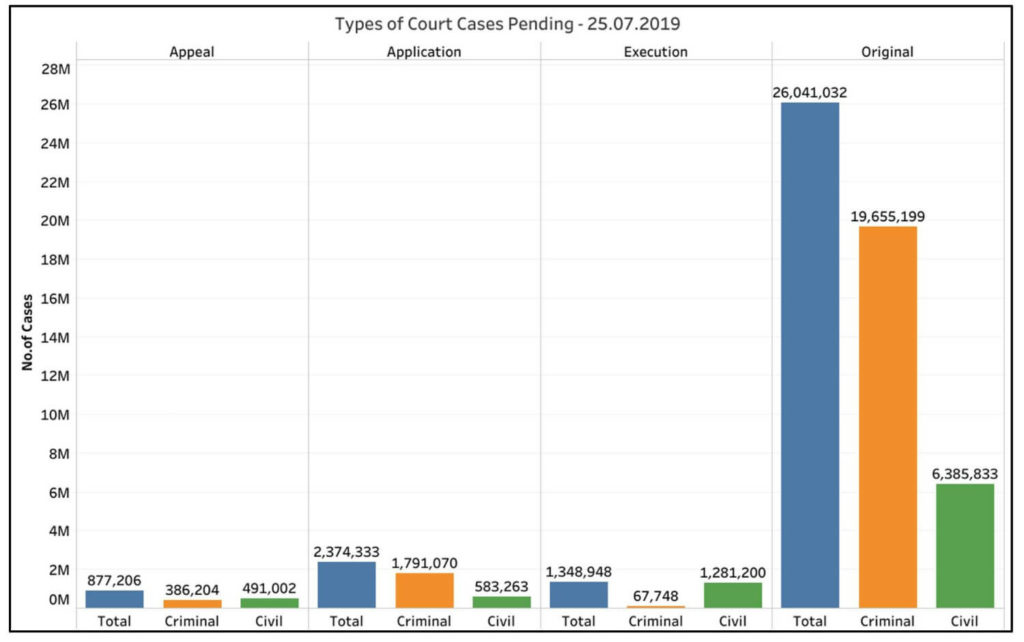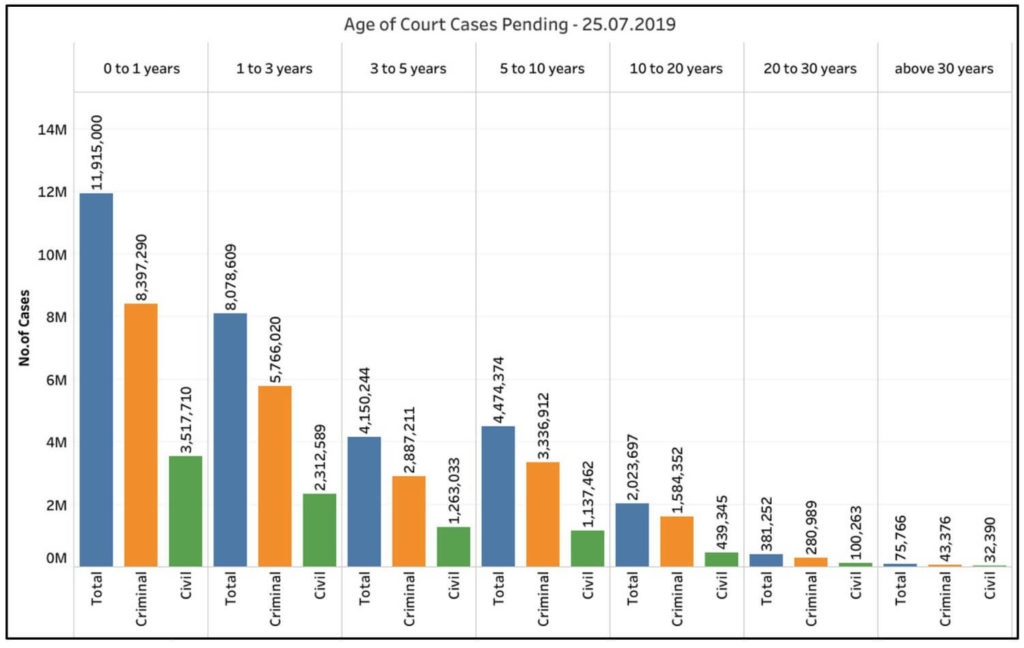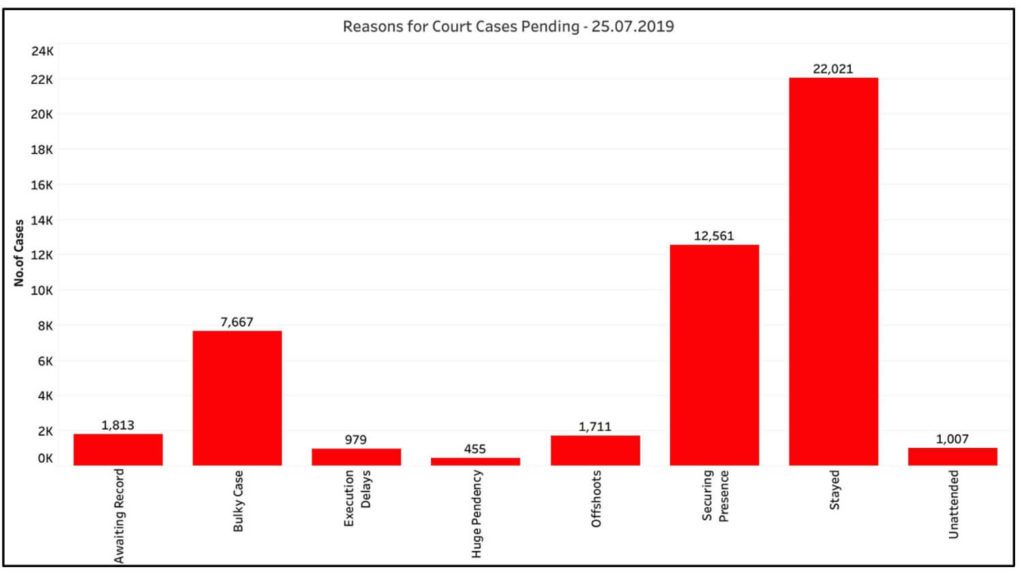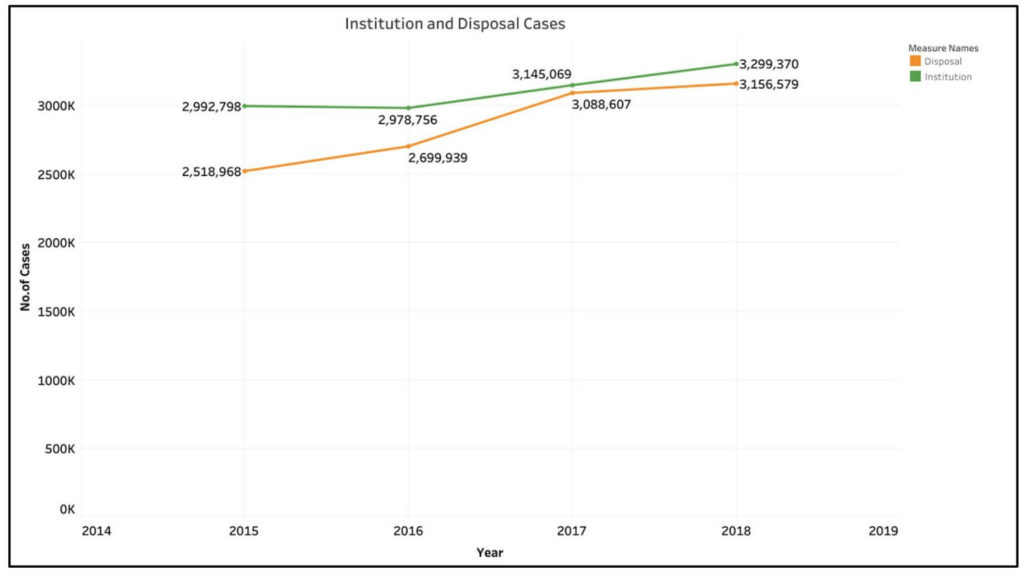Pendency in Indian courts is not a new phenomenon. For years now, the judicial system has been plagued with a high number of pending cases. Latest data from NJDG indicates that more than 3.1 crore cases are pending in the lower courts with 36% of them being more than 3-years old.
[orc]
Indian constitution lays down the provision for the setup and functioning of Judiciary in India. Article 124-147 , of Part V -Chapter IV has the provision of Supreme Court, while Articles 214-231, of Part VI Chapter V deals with rules , regulations and provision of the High Courts. Our Constitutions also provides provision for Subordinate Courts through Articles 233-237, under Part VI Chapter VI.
The Judicial system in India works in a defined hierarchy with Supreme Court being the Apex institution with each state having a High Court. District courts and other subordinate courts function at the district level & below. With detailed provisions in the constitution, the Indian Judiciary works as an independent organization without the interference of the Executive or Legislature. This framework is for the citizens of India to seek and gain justice in line with the tenets of Constitution of India.
While the framework is ideal, the efficacy of the Judicial system in delivering justice is being highly compromised due to the issue of pendency in court cases leading to inordinate delay in the disposal. We look at the issue of pendency in district & lower courts.
Nearly 3/4th of Pending cases are pending for more than a year
As on 25 July 2019, a total of 3,10,99,044 cases are pending in the District and Taluka Courts across India. Of these, nearly 73 % of the cases are pending since more than a year.
The National Judicial Data Grid (NJDG)provides the details of all the cases across the courts in India. This is part of the e-courts Integrated Mission Mode Project that helps to monitor and track the performance of the courts.
As per the data on NJDG, out of the total pending cases – nearly 72% are criminal cases and the rest are Civil Cases. The proportion of cases pending for more than one year, in both Criminal cases and Civil cases is high with 73% and 71% respectively.

Original Cases occupy a major share in the type of pending cases
Of all the cases currently pending with the District courts, 73% of original cases. In other words, these are the cases in which the original hearing occurred in the respective courts.
Out of the Original cases filed, a major portion of the pending cases are Civil Suits (68.14%).
Cases related to MACP are nearly 16% of pending Original Cases. MACP is a promotion scheme for central government employees. Land Reference cases, Marriage Petitions, Labour Court cases are few of the other major types of Original pending cases.
Around 6% of the pending cases are “Appeal” cases which are filed to review, amend and overrule the decisions that are made in the trial court or other lower courts.
Another 7% of the pending cases are “Application” in nature i.e. these are the applications received, like for example Bail Application or Applications received for fast tracking a case etc. Nearly 15% of the pending cases are Execution Petitions i.e. these are the petitions filed in the courts to execute a decree or an order.

Nearly 36% of the pending cases are more than 3-years old
As on 25 July 2019, a total of 1,11,05,333 pending cases are more than 3 years old i.e. nearly 36% of the total pending cases. Further, there are 44,74,374 cases which are 5 to 10 years old with nearly 3/4th of them being criminal cases (33,36,912).
A total of 4,57,018 pending cases are more than 20 years old, with 75,766 cases of them being pending for more than 30 years. A majority of these long pending cases (of more than 20 years) are criminal cases (71%).
It would be surprising to note that 1913 cases categorized as “Pre-Trial” are more than 20 years old. Pre-trail stage is the stage between opening of the case and start of trial proceedings in the court.

‘Stay’ is the main reason for Pending cases followed by ‘Securing Presence’
There are various reasons for the court cases to be pending. The NJDG portal has details of 48,214 cases along with the reason for the case being pending. It has to be noted that this number is just a sample of the total pending cases with the data for being available only for these cases.
Of this, ‘Stayed’ is the reason for pendency in 45.67% of the cases. Nearly 26% of the cases are marked as pending because the law enforcement authorities were unable to secure the presence of the people required for the court hearing. Another 16% of the cases are pending because of being bulky cases.

Improvement in disposal does not reduce pendency because of increase in new cases
The number of cases being disposed-off every year has seen an increasing trend over the last four years. However, the number of new cases registered every year has also been on the rise over the years. This is resulting in new cases being piled up over the already existing cases.
The number of cases disposed for 2015 was 25,18,968 where as the number of cases disposed in 2018 was 31,56,579 which is an increase of almost 25%. However, the corresponding figures for Instituted (new) cases were 29,92,798 and 32,99,370 respectively. Such increase in the new cases has also added to the pendency.
So far in 2019, a total of 17,54,963 cases have already been disposed, but at the same time, 18,13,957 cases have been registered.

Government being the major litigant and lack of initiatives contributing towards pending cases
Pendency of Court cases has been a longstanding problem plaguing our Judiciary system. There are many reasons that contribute towards the pending cases. Few of the important ones include:
- Fewer Judges: The Law Commission of India Report-1987 recommends to increase the ratio of judges to 50 per Million population. However, with a population of 1.30 billion, the number of judges is only around 21,000 which is much less than half of the recommended ideal number of judges for the population.
- Vacations and Other Holidays: The colonial practice of courts being on a holiday for a long period of time during summer and other holidays, reduce the number of days the court functions.
- Fewer Number of Courts: The number of courts are far fewer than what is ideally required to deal with the number of cases and the population. Additional courts, benches etc. can help to relieve the pressure on current courts.
- Government is the largest litigant: In nearly half of the cases, Government is the litigant. More cooperative work between the various departments can help to reduce the pending cases and prevent new ones. The National Litigation policy and the launch of the Legal Information Management Based System (LIMBS) platform are steps in the right direction.
- PILs and RTI: Increased awareness has also contributed to a greater number of people filing new cases. While this is a desired development, more prudence on the part of those filing the cases would be a progress in right direction.
Featured Image: Pendency in Indian Lower Courts



2 Comments
NO need for more courts. Misplaced sympathy ( support and protection ) provided by courts to wrong doers + corruption is the root cause for pendencies of cases.
The Judge in Vanur Munfic court, District Villupuram, TN comes to office 2 or 3 times a week, sits with the laiers, sorry lawyers on their table, chats throught the 4 or 5 files, then retires home. At 10 the slerk gives out automatic dates. This is on for the last 3 years.